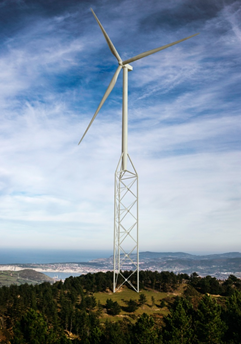The Spanish company has certified the entire Nabralift 2.0 tower family, made up of three tower configurations that cover hub heights of between 140 and 190 meters.
Nabralift 2.0, the new family of self-lifting towers from Nabrawind, has received the “Design Evaluation Conformity Statement” from DNV. The Nabralift 2.0 tower catalog is made up of three standardized towers covering hub heights between 140 meters and 190 meters. Consequently, Nabralift 2.0 HH190 has become the tallest tower in the world to achieve this certification.
A windmill in an open area Auto-generated description with medium confidence Nabralift 2.0 offers three distinct tower configurations that differ in the number of modules that make them up and ultimately result in different hub heights: Nabralift 2.0-3F (three modules under the transition piece), for hub heights between 140-155 meters; Nabralift 2.0-4F, for hub heights between 160-175 meters and finally Nabralift 2.0-5F for hub heights between 175-190 meters.
DNV confirms with this certification the structural strength and compatibility of the Nabralift 2.0 tower for wind turbines with a power of 4.X MW and 5.X MW. The first Nabralift 2.0 will be installed this year in the fourth quarter of 2020 in Oualidia (Morocco), in a wind farm developed by the French developer InnoVent, and will consist of a 3F model with a 144-meter hub height.
In this way, Nabrawind expands and ensures, with its high tower product portfolio, compatibility with all wind turbines. Thus, Nabralift 1.0 is available for demand from wind turbines up to 3MW. Nabralift 2.0 covers the power range from 4MW to 5MW. And finally, Nabrawind is developing Nabralift 3.0, which will be the most suitable option for towers starting at 6MW.
Nabrawind team satisfaction with Nabralift 2.0 performance
Cristina García, Director of the Nabralift 2.0 Certification Project, affirms the «importance» of obtaining this certificate, since «it reaffirms that the design of the tower is very solid and that we have been able to demonstrate to DNV that the structure is capable of operate safely even in the worst wind and operating conditions.
For his part, José Antonio Amezcua, Director of Marketing, Sales and Corporate Business Development, highlights the “growing interest in high-rise towers that the market is showing” and underlines that “our family of certified Nabralift 2.0 towers is ready to satisfy all the demands of the wind market ”.
About Nabrawind Technologies
Nabrawind Technologies S.L. is a Navarran company, owned by SODENA, that designs and develops advanced wind technologies. It was founded in 2015 in Pamplona in order to develop two patents that the promoters had requested in the parent company Nabrawind S.L.
Since then, Nabrawind has developed three innovative products: Nabrajoint, Nabralift, and BladeRunner.
Nabrajoint consists of a union of modular blades compatible with any blade and whose assembly can be carried out at the foot of the wind turbine in a short period of time.
Nabralift is a self-lifting tower that can reach 200 meters in height without the need for large cranes. providing minimal LCOE and breaking down logistical and installation barriers.
Finally, BladeRunner is a new blade installation and removal system that reduces the cost of replacing blades by 70% compared to maintenance operations performed with cranes.
InnoVent is an independent French renewable energy development company operating in France and Africa, founded in 2001. Thanks to its team of 90 people, InnoVent dominates the entire development chain, from preliminary studies to operations and maintenance, passing for financing. InnoVent achieved consolidated revenues of € 55 million in 2020.
To date, InnoVent has installed 48 wind farms in France, or 173 wind turbines, located mainly in northern France, Brittany and Normandy.
For 10 years, InnoVent has expanded its activity in Africa, where the company is present in a dozen countries (Namibia, South Africa, Senegal, Benin, Kenya, etc.), including Morocco. In total, InnoVent has developed 600 MW in France and Africa since its inception, including 300 MW in wholly-owned ownership.


